Fujifilm X-T100 Review
Fujifilm X-T100 Introduction
The Fujifilm X-T100 introduces a new intermediate-level variant to the highly-acclaimed APS-C mirrorless series that includes the excellent X-T20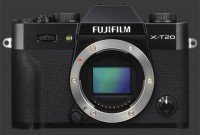
Fujifilm X-T20 and X-T2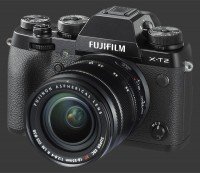
Fujifilm X-T2 with hybrid digital and analog design. The X-T2 is the top-of-the-line professional-grade model, while the X-T20 is a smaller non-weatherproof version which is nearly as feature-rich. Both digital cameras are built around a Fujifilm sensor with a unique 6x6 Pseudo-Random X-Trans Color-Filter-Array.
Fujifilm's new X-T100 offers a similar hybrid analog and digital design in a similar size to the X-T20 except with a standard 24 megapixels APS-C CMOS sensor with Bayer Color-Filter-Array. This sensor is shared with the entry-level X-A5 and comes with a slower processing pipeline than the higher-end X-T series offerings. The X-T100 still retains a moderate-size 0.39" EVF with 0.62X magnification, with 2.4 megapixels and a built-in Eye-Start Sensor while squeezing in a third control-dial to compensate for having fewer external controls.
With 24 megapixels of resolution and a broad ISO 200-12800 range, expandable to 100-51200, the APS-C CMOS sensor in the X-T100 is ready to deliver high image-quality under a variety of conditions. Its hybrid shutter mechanism can freeze action at 1/32000s and take bulb exposures of up to an hour. This sensor is paired with a processor that lets it shoot continuously at 6 FPS for 24 frames and capture 4K Ultra-HD video at 15 FPS or 1080p HD video at 60 FPS.
This mirrorless digital camera offers a good number of controls, including triple control-dials previously mentioned which have never been seen in this price range. Given that most Fujinon lenses also have an aperture-ring, this gives the X-T100 plenty of control-points. Framing is highly flexible with the built-in 2.4 MP 0.39" EVF, a 3" LCD mounted on a 3-way hinge and optional Camera Remote Application running over Bluetooth 4.1 LE and WiFi. The LCD is also a touchscreen with flexible customization options.
This digital camera review analyses the usability, performance and image quality of the Fuji X-T100.
Fuji X-T100 Features
Sensor
- 24 Megapixels CMOS sensor
- Standard Bayer Color-Filter-Array
- Anti-Alias (Low-Pass) Filter
- 1.5X Crop factor (APS-C)
- 3:2 Aspect ratio
- Fuji XF lens mount
- Dust-Reduction
Exposure
- ISO 200 to 1280 sensitivity range, 1/3 EV steps
- ISO 100, 25600 and 51200 expansion, JPEG only
- Auto ISO, Selectable maximum from 400 to 6400
- ISO Bracketing, 3 frames, 1/3-1 EV steps
- PASM Exposure modes, plus Bulb up to 1h
- 1/4000-30s Mechanical Shutter, 1/3 EV steps
- 1/32000-30s Electronic-Shutter, 1/3 EV steps, Expanded ISO not available
- 1/32000-30s, Electronic Front-Curtain-Shutter, Expanded ISO not available
- Multi-Segment, Spot and Average metering
- Exposure-Compensation, ±5, 1/3 EV increments
- AEB, 3-9 frames, 1/3-3 EV increments
- 100%, 200% or 400% Dynamic-Range
- Dynamic-Range Bracketing, 3 frames
- Flash-Compensation, ±2, 1.3 EV steps
- Auto, Forced, Slow-Sync, Rear-Sync, Wireless and Off Flash modes
Image Parameters
- Automatic, 7 presetsSunny, Shade, 3 Fluorescents, Incandescent, Underwater, Kelvin and Custom WB
- WB fine-tuning along 2 axis in 19 steps
- Film Simulation: Provia, Velvia, Astia, Classic Chrome, Pro Negative High, Pro Negative Standard, B&W, Sepia
- Film Simulation Bracketing, 3 frames
- Adjustable Color, Sharpness, Highlight Tone, Shadow Tone and Noise reduction, 5 steps each
- Optional Long-Shutter Noise-Reduction
Focus
- Focus Drive: AF-S, AF-C, DMF, MF
- 91-Point Hybrid Phase-Detect & Contrast-Detect AF
- Focus Selection:
- Point: 5 Area-Sizes
- Zone: 3 Zone-Sizes
- Automatic or Tracking
- 4K Burst Photo Stacking
- Optional Face-Detection with Eye-Detection
- Optional MF-Assist: Electronic Zoom or Peaking
- Optional Pre-Autofocus
- Optional AF-Assist lamp
- Fly-By-Wire focus-ring on lenses
Drive
- 6 FPS Continuous Drive, 24 JPEG or RAW
- 4K Photo Burst, 15 FPS, 30 Frames
- Self-timer: 2s or 10s, Face, Smile, Buddy, Group
- Built-in HDR, 2 frames, 1-3 EV Range, 1/2 EV steps
- Interval Timer, 1s-24h Interval, 1-999 Frames
- Multiple Exposure, 2 Frames
- Motion Panorama mode
Video
- 3840x2160 @ 15 FPS 4K Video
- 1920x1080 @ 30 FPS Full-HD Video
- 3840x2160 @ 30 FPS 4K Time-Lapse Video
- 1920x1080 @ 60 FPS Full-HD Time-Lapse Video
- Focus Drive: AF-S, AF-C or MF
- Quicktime H.264 format
- Built-in stereo microphone
- Audio Input Mini-Jack
Display & Viewfinder
- 0.39" EVF
- 2.4 Megapixels
- 0.62X Magnification
- 100% Coverage
- Eye-Start Sensor
- 3" Tilting Touchscreen LCD, 1 megapixels
- Optional Live-Histogram
- Optional Framing-Guides, 3 types
Output Processing
- 3:2 Native aspect ratio
- 16:9 and 1:1 cropped aspect ratios
- 24, 12 and 6 megapixels modes
- JPEG, RAW, RAW+JPEG capture
- 2 JPEG Compression levels
Misc
- Triple control-dials
- Traditional mode-dial
- Customizable Fn button
- Wired Remote terminal
- Standard Hot-Shoe
- Built-In popup flash
- Lithium-Ion battery
- Internal charging
- SDXC memory
- Built-in WiFi
- Bluetooth 4.1 LE
- HDMI (1080i) output
- USB 2.0 connectivity
Fujifilm X-T100 Usability - How easy is it to use?
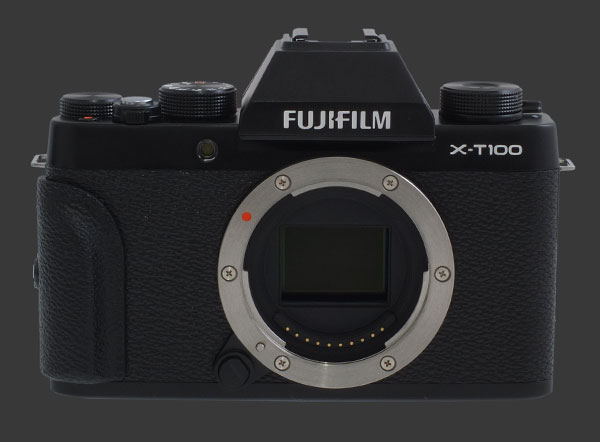
While it sports a strong angular design like other Fujifilm mirrorless and the recognizable EVF housing the the mid-range X-T20, the X-T100 mixes elements from the X-T20 and X-A5 to produce a unique design which is decidedly Fujifilm. Its camera body is mostly rectangular with a prominent hump which houses a 0.39" EVF with 2.4 megapixels and 0.62X magnification plus an essential Eye-Start Sensor. The camera itself does not have a grip yet it comes with a small attachable one which makes a huge difference is ergonomics.
This camera has a top metal layer with a metallic finish above a hard rubber-coated plastic body. The fine texture does not provide much purchase over the camera which is why the provided detachable grip makes such a difference. Without the grip, the front of the camera is flat with the exception of the mandatory lens-release button at the base of the X-mount. In hand, the camera feels moderately solid and relatively light. One can feel comfortable with either a wrist-strap or the provided neck-strap for added security.
The front of the Fujifilm X-T100 is quite bare. Then lens mount almost reaches a slight protrusion which houses a built-in popup flash. On one side of it, the X-T100 logo is found. On the other, a bright AF assist lamp which also serves as indicator for the self-timer. There are no controls on the front, not even a focus-switch present on many other Fujifilm mirrorless. Instead, focus must be changed via the menu system or the touchscreen. More on this further down in the review.
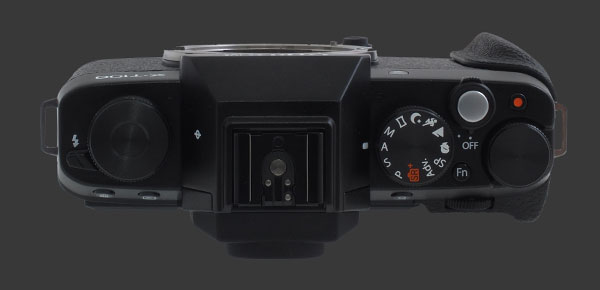
On top of the X-T100, there are quite a few controls. Starting on the left, there is a large prominent control-dial with strong detents. This one is customizable to change a number of settings, most importantly ISO sensitivity. For some odd reason though, this dial - and only this dial - ignores the first turn. This should be an easy bug to correct for Fujifilm via firmware yet makes it easy to be off-by-one when switching settings. Since ISO is mostly selected in 1/3 steps, one must turn the dial 4 times to increase ISO by one full stop! At the base of this control-dial, there is a small spring-loaded mechanical latch to release the built-in popup flash.
Right above the lens mount, the EVF housing sports a standard hot-shoe to accommodate an external flash. On the other side, there is a traditional Mode-Dial with 12 positions. The ubiquitous P, A, S, M modes are there with Bulb exposures part of M mode. A Motion Panorama position allows to capture a panoramic image right in-camera by sweeping in any of the 4 cardinal directions. The camera supports both standard and wide panoramas which are 120° and 180° respectively. Dedicated positions for Night, Sport, Landscape and Portrait modes follow. An SP position gathers remaining Scene Positions. Oddly, this is where the Multiple Exposure feature is hidden. The Adv position selects different post-processing filters, while the SR+ one provides automatic Scene Recognition.
A tiny Fn button near the base of the Mode-Dial is the only actual customizable button on the X-T100. There are a whopping 30 options to choose from, including Depth-Of-Field Preview which cannot be accessed any other way, Towards the front of the top-plate, a small two-stage shutter-release with a distinct halfway point is surrounded by a rotating power-switch. To the right of the shutter-release, there is an absolutely tiny Video Record button. One must press it down quite firmly to start video recording. There is no other way to film as this camera does not have a dedicated video mode. This also makes it impossible to preview video framing correctly on the X-T100.
The last control found on the top-plate is a dual-purpose control-dial. In Manual mode, this dial selects the shutter-speed. The range is 1/4000-30s, plus Bulb, when using the Mechanical-Shutter, or 1/32000-30s with the Electronic-Shutter. Using EFCS, the full-range of shutter-speeds is available. In all other exposure modes, this dial sets Exposure-Compensation ±5 in 1/3 EV steps. It has nice firm detents to prevent accidental changes to exposure.
Sides of this digital camera are quite bare. On the left hand-size, there is a tiny and rather flimsy rubber flap that covers a 2.5mm jack used for a wired remote release. On the right hand side, there is a slim plastic door. It is somewhat flimsy but certainly much better than the rubber flap on the other side of the camera. This is important since this door needs to be used pretty much daily. Behind it, there is a Micro-HDMI port that supports 4K output. The catch is that when 4K is send through the port, it cannot be written to the card. Below it is a standard Micro-USB connector which is used for charging. Unfortunately, the camera does not come with a charger which means tying it up while a battery is being charged.
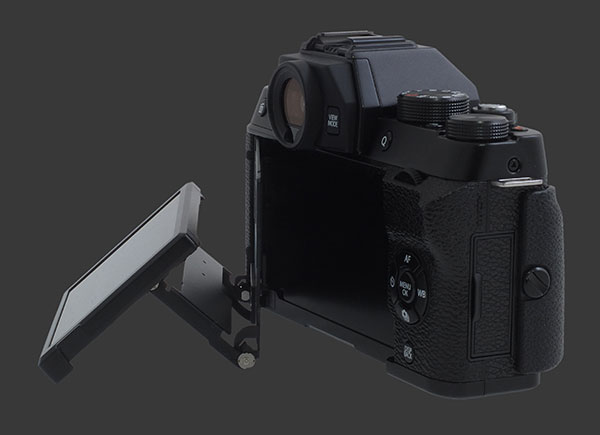
All remaining controls of the X-T100 are found on the back of the camera. A large 3" Touchscreen LCD with one megapixel and 3:2 aspect-ratio dominates the back. The display itself has good visibility with an effective anti-reflective coating and shows 100% coverage. It is mounted on an unusual and somewhat puzzling triple hinge. This design provides a lot of flexibility while being much more durable than rotating screens. It does take more work though to orient it the desired way. This is particularly obvious when trying to raise it to shoot from a low angle since it has the tendency to swing outwards at the same time.
Fujifilm provided plenty of touch functionality and some customization option for it. While it could be useful, in practice this is a bad idea. After a few days of shooting, the display got covered with fingerprints and the camera countless times had changed settings inadvertently. It is too error prone, so it was turned off for the final shooting days. This is a trend among digital cameras that we rather would go away.
Above the LCD there is nice 0.39 EVF which protrudes slightly from the back of the camera for added comfort. While not large, it provides a good 0.62X magnification and 100% coverage. A built-in Eye-Start Sensor at its base switches automatically between the EVF and LCD. To its right, a View Mode button controls the behavior of the Eye-Start Sensor. By default it switches between the EVF and LCD. It can also switch the EVF on and off while keeping the LCD off to lower battery consumption. The remaining two View Mode options are EVF Only and LCD Only.
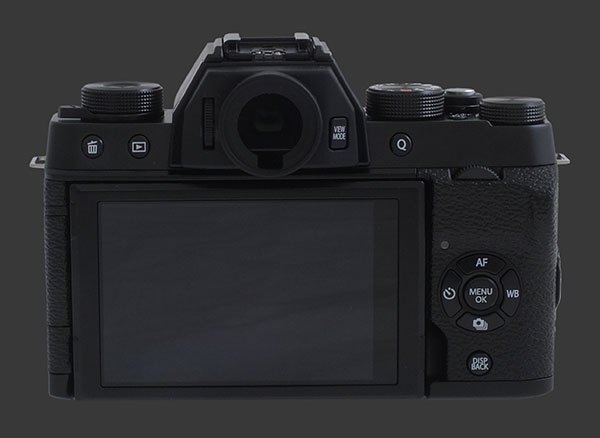
Behind the top-plate and to the left of the EVF, there are buttons for Delete and Playback. These work as excepted and the Delete button does nothing in Capture mode. On the other side of the EVF, still at the same level, a Q button invokes the now Fujifilm class Quick Menu of 16 icons. As with recent Fujifilm mirrorless cameras, this menu is also customizable on the X-T100.
The back of the camera hosts a control-dial which is actually the primary one. It is mounted vertically and has softer detents than the other two dials, although its position makes accidental changes unlikely. In Aperture Priority and Manual mode, this dial selects the shooting aperture but only if the lens does not control aperture with its Aperture Ring. Most Fujinon lenses have a dedicated Aperture-Ring, so this control-dial is not used so often. In Shutter-Priority and Program modes, the rear control-dial controls shutter-speed. This shifts exposure in Program mode, giving roughly the same behavior as Shutter-Priority mode. The dial is clickable to activate Manual Focus Assist which magnifies a region around the focus-point or area.
The 4-way controller with central OK/Menu is made of 5 separate buttons. Each button is assigned a function in Capture mode:
- Up: AF Point Selection in Capture mode which only works if the manual AF-point mode is active.
- Right: Presents a vertical menu of WB options. Pressing Right again from there enters the WB Fine-Tuning interface with a step to measure Custom WB.
- Down: Brings up a lengthy two-level menu to select Drive modes:
- Still Image: Simple single shot capture.
- Continuous: 6 FPS with maximum 24 frames and 3 FPS up to 50 frames.
- 4K Burst: 15 FPS Burst of 4K images or Focus Stacking from a 4K Burst. Either way, there is a crop applied yet the image aspect-ratio is preserved.
- AEB: No options right there but plenty in the menu. 3-9 Frames, Continuous or Single shot plus various ordering.
- ISO Bracketing: ±1, 1/3 EV steps
- Film Simulation Bracketing: 3 Frames with Film Simulation chosen in the Shooting menu.
- White-Balance Bracketing: 3 Frames, 3 step sizes.
- Dynamic-Range Bracketing: Always uses 100%, 200% and 400%, clamped to available options.
- HDR: Built-in HDR image merged from 2 frames taken at 1-3 EV apart, ½ EV step sizes.
- Left: Shows a vertical menu for the Self-Timer with positions for 2s, 10s, Face, Smile, Buddy with 3 levels of closeness, Group of 1-4 people or Off. These middle options trigger based on analysis of faces in the frame.
The last button is DISP/BACK right below the 4-way controller. The display buttons cycles over display modes with one being customizable. This modes allows to see a single-axis Digital Level and various grid lines. Although one option marks the 16:9 aspect-ratio, it does not correspond to the video capture area since that is taken from a crop of the sensor, at least at 4K Ultra-HD resolution.
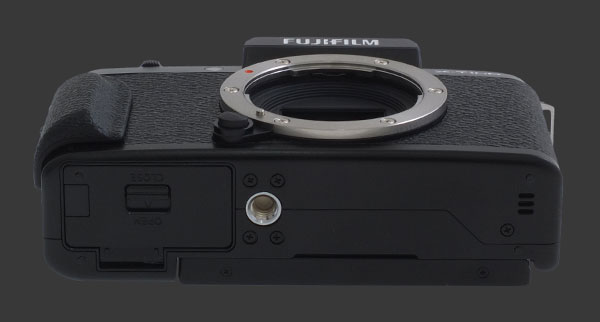
The bottom of the Fujifilm X-T100 has a metal tripod mount which is neither in-line with the optical axis nor with the center of gravity of the camera. There is also a single compartment door which gives access to both the SDXC card and the Lithium-Ion battery. Since the door is really close to the tripod mount, it is not possible to change memory or battery while the camera is on a tripod or even just fitted with a quick-release plate.
The Fujifilm X-T100 offers an impressive set of control-points fro an intermediate level mirrorless. Its triple control-dials make it more efficient than its peers and the traditional Mode-Dial allows it to be more easily understood than top-of-the-line Fujifilm offerings. A few crucial features require a trip through the menu system or at least the Q menu but overall, this camera is simple and efficient to use. The EVF and LCD unfortunately both fail to preview exposure reliably which means more poorly exposed images than ideal.
Fujifilm X-T100 Performance - How well does it take pictures?
Performance starts with image quality, which is the criteria used as the foundation of our digital camera ratings. Ergonomic issues may get in the way, but in the end, image quality counts the most. For an ILC, image quality greatly depends on the lens used. While color, noise, exposure and dynamic-range are properties of a camera, distortion, vignetting and chromatic aberrations are properties of the lens. Sharpness and contrast depend on the weakest link. That is, a camera cannot capture more details than a lens lets through. Conversely, it is quite possible for a lens to transmit more details than a sensor can capture.
Image Noise & Details
Image-quality from the Fuji X-T100 is very good. With virtually the same sensor at those used on cropped-sensor DSLRs, it unsurprisingly produces highly comparable images. This mirrorless renders very good images with virtually no noise all the way to ISO 1600. It becomes barely detectable at ISO 3200 which where noise-reduction introduces a jump in softness. Inline with the target audience of this camera, noise-reduction is more aggressive than on other Fujifilm mirrorless.
ISO 6400 is very smooth, overly smooth actually which takes a toll on details. While noise-reduction manages to completely hide noise, it comes with a significant jump in softness. Image quality goes down progressively from there with ISO 12800 and even 25600 surprisingly both usable for small prints. The new ISO 51200 reach looks like watercolor, so it is not really usable.
Sharpness is controllable in 5 levels. Things start from a very soft to over-sharp, so each step is quite coarse. The default level is slightly over-sharpened yet quite acceptable for common print sizes. Noise reduction also comes in 5 steps with an aggressive default. Taking it down one or two levels improves things but it never turns off and always gets gradually stronger as ISO increases. The default setting of 0 is fine for low ISO sensitivities. When shooting above ISO 1600 though, one could turn it down to -1 to maintain slightly more details.
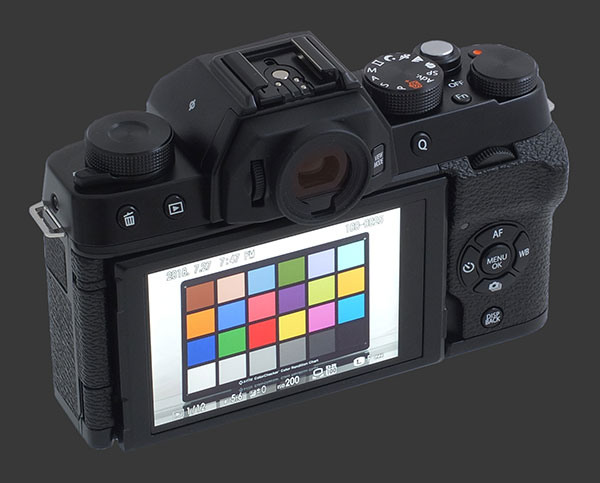
Color & White Balance
Color accuracy of the X-T100 is very good. Hues are realistic with different Film Simulation modes mostly affecting saturation. The standard Provia mode slightly exaggerates saturation without making colors unrealistic. The default tone-curve gives punchy results straight out of the camera. One can reduce the amount of clipping by adjusting Highlight Tone and Shadow Tone down. Setting both to -1 conserves more dynamic-range without making images to look flat.
Automatic White-Balance is dependable under typical conditions. It handles natural light relatively well yet struggles more than usual under artificial lighting, leaving a bluish cast. It really depends on the exact situation, yet it rarely gets very pronounced. A Custom White-Balance option is there for difficult situations and is more accurate.
Exposure
The Multi-Segment metering system of the X-T100 has a strong tendency to overexpose scenes which fall outside of the dynamic-range that the camera can capture. This produces bright images and frequent clipping of highlights. It often needs to be tuned down around -2/3 EV but rarely more. The uncertainly when shooting with the X-T100 is compounded because the LCD shows an even brighter image. Lowering LCD brightness improves things only slightly and one can see that as soon as the Instant Review pops up, if enabled, the frame already looks better with less clipping.
Dynamic-Range of the X-T100 is good when increased to 200% starting at ISO 400 or to 400% starting at ISO 800 which is possible all the way to all the way to 12800 now. Unfortunately, the metering system is skewed to clip highlights which is too bad considering how much dynamic-range the X-T100 can capture. Dialing EC to -2/3 or -1 often restores highlights. It will however render a dark scene when overall contrast is less than the dynamic-range of the camera.
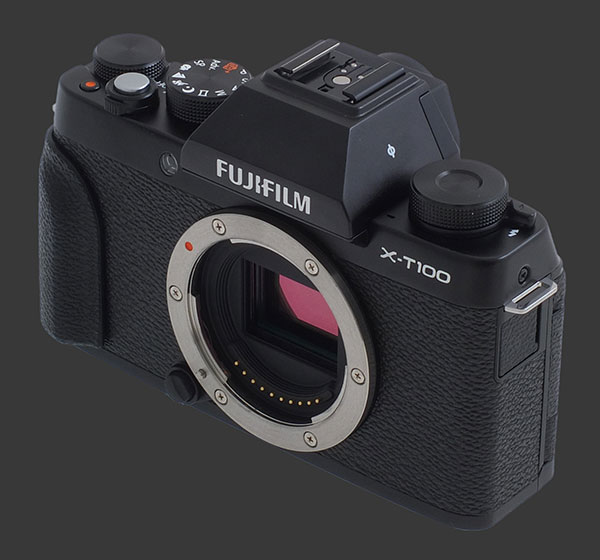
Auto Focus
A 91-Point Hybrid Phase-Detect and Contrast-Detect AF system is built into the X-T100 sensor directly. The Phase-Detection pixels are not very sensitive but aid the camera to find focus faster. Contrast-Detect is then used to refine focus and is very flexible in coverage and area-size. The result is an decent speed AF system with below average sensitivity. In low light, it gives up quickly which gets quite frustrating after sundown.
The Hybrid AF system presents a choice of 91 areas with 5 area-sizes or 3 zone-sizes. In practice, it can focus nearly anywhere in the image with higher accuracy within a square area in the middle of the frame. The camera can use this to tracking a face or even a eye. The same system is used to trigger the multitude of self-timer options which detects smile, proximity and number of people, although less accurately than one would hope.
Autofocus speed is below average for a modern mirrorless. It can take anywhere from ½ to 1s for the X-T100 to lock focus or give up. Most times it locks in about 3/4s which is somewhat slow and certainly cannot cut it for moving subjects. Tracking AF is sluggish and tends to lag behind movement.
Speed
With two exceptions, the Fujifilm X-T100 is reasonably responsive. As mentioned above in this review, the third control-dial which is mounted on the top left shoulder of the camera, ignores one turn, every single time. One gets used to this but it is still an issue. More crucially, the tiny Video Record button takes over 2s to respond. This is simply not acceptable for video There is no Video mode on the X-T100, so the camera is simply never ready to capture video. This lack of a video mode prevents it from previewing video framing. Even with the HD guidelines enabled, it is not accurate since those just mark the 16:9 ratio over the entire image area while video is taken from a crop of the sensor.
The X-T100 can shoot continuously at 6 FPS which is the same speed as the basic X-A5 and quite short of the X-T20 which can reach 14 FPS. Mid-range DSLRs shoot at around this speed nowadays. The buffer is capable of handing 24 JPEG images or 20 RAW files, in a single burst. At 3 FPS though, the buffer keeps up with 50 JPEG per frames, though still about 20 RAW files. Exact numbers, depend on memory card speed.
The following measurements characterize the performance of the Fujifilm X-T100:
- Power-On: 1½s. On the slow side of average.
- Power-On to First-Shot: 3s. Definitely slow.
- Autofocus: ½-1, depending on the light. Below average.
- Shutter-lag: Immediate with slightly under ½s blackout. Good.
- Shot-to-shot: 1½s with AF. A little slower than average.
- Playback: ¼s to enter, ½s to exit. Good.
- Power-Off: 1-1½s, depending if sensor-cleaning is performed. Good.
- Video: 2½s to start. Glacially slow.
Those numbers are very mixed. While shutter-lag and changing modes are good, autofocus and shot-to-shoot speeds are definitely slow. The rest of the performance remains below average, particularly for the video lag and time-ot-first-shot. This camera is not suitable for capturing any type of action.
The Fujifilm X-T100 is powered by a small proprietary Lithium-Ion battery which provides 430 shots-per-charge. This is a little better than average. Still, another battery is highly recommended not to run out unexpectedly.
Fujifilm X-T100 Conclusion
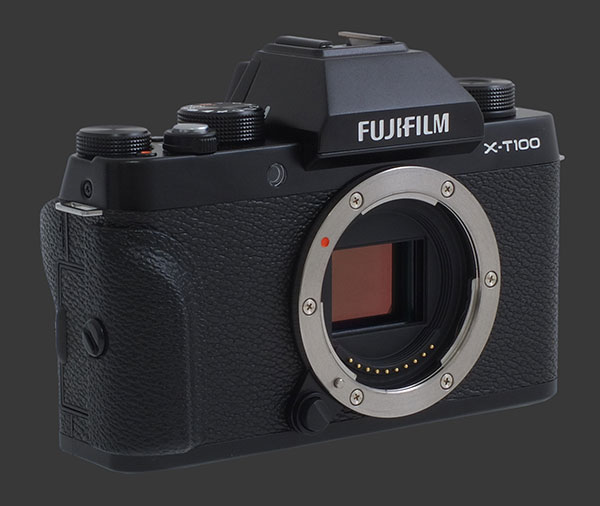
Fujifilm introduced the X-T100 as an intermediate level mirrorless, slotting it between the basic X-A5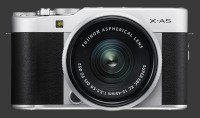
Fujifilm X-A5 and mid-range X-T20
Fujifilm X-T20 with an unusual mix of features for this level of digital camera. Taking the lower-cost 24 megapixels CMOS sensor with traditional Bayer Color-Filter-Array and Anti-Alias Filter of the X-A5 and placing it into a more ergonomic body having a built-in 2.4 megapixels 0.39" EVF with 0.62X magnification and Eye-Start Sensor, plus triple control-dials, makes the X-T100 unique on the market.
The 24 megapixels APS-C CMOS sensor in the X-T100 has already proven to deliver exceptional image-quality as show in the X-A5 review. Image quality is very good with low image-noise, good dynamic-range and nicely saturated colors. Exposure though could really be improved as the X-T100 has a strong tendency to overexpose in order to produce bright images. White-Balance is not perfect but rarely an issue outside of dim artificial light.
The principal delineating-point of this mirrorless compared to its higher-end sibling is speed. At 6 FPS, the X-T100 is about the speed of a DSLR when it comes to continuous shooting, but it is the hybrid Phase-Detect and Contrast-Detect AF system that struggles. It takes longer than usual to lock focus and gives up even in moderately low light. Remaining performance numbers are also between below average down and very slow with a 2+ second video recording lag. Video performance as a whole is just not there. Not only is 4K limited to 15 FPS, the X-T100 lacks a video mode and makes it impossible to preview video framing correctly.
Ergonomics of this digital camera are very good for this price-point. Triple control-dials, plus a traditional mode-dial and aperture-ring on most lenses, makes the X-T100 quite efficient to use. As noted though in this review, the third dial skips one click for some reason. Buttons and dials are well-placed and have good detents to prevent accidental changes. The only real usability issue of the X-T100 is its misleading EVF which is not Exposure-Priority and often gives the impression of even more over-exposure than will actually occur.
Overall, this is a much easier camera to recommend than the X-A5. It delivers the same high image-quality with a much improved experience. Exposure may still not be previewed correctly but at least framing is accurate. Some functions require trips through the menu system yet most important controls are on hand or at least can be customized into the Q menu. Having a large 0.62X magnification EVF makes a huge difference too, allowing more stable shooting and superb visibility is strong light.
 |
Please Support Neocamera
All information on Neocamera is provided free of charge yet running this website is a huge endeavor. Purchases made via affiliate links found throughout the site help keep it running and up-to-date. There is no additional cost to you, so please consider buying via these links to our affilates:
If you found any information on this site valuable and did not purchase via our affiliate links, please considering donating via PayPal:
Any amount will be greatly appreaciated. Thank you for your support!
Fujifilm X-T100 Highlights

Sensor-Size: 24 x 16mm

Actual size when viewed at 100 DPI
| 24 Megapixels Mirrorless | ISO 100-51200 |
| Fujifilm X Mount 1.5X FLM | Shutter 1/32000-30s |
| 0.39" Built-in EVF 2.4 Megapixels (0.62X) | Full manual controls, including Manual Focus |
| Automatic Eye-Start sensor | Custom white-balance with 2 axis fine-tuning |
| 1 Axis Digital Level | Spot-Metering |
| Built-in Dust Reduction | Hot-Shoe |
| 6 FPS Drive, 24 Images | Stereo audio input |
| 3840x2160 @ 15 FPS Video Recording | Lithium-Ion Battery |
| 3" LCD 1 Megapixels | Secure Digital Extended Capacity |
Updates
2025.01.18

Fujifilm GFX 2025 Lens Roundup
Lens Review roundup of Fujifilm GFX Medium-Format lenses. Quality, performance and handling of the GF20-35mm F/4R WR, GF30mm F/3.5 Tilt-Shift and the GF55mm F/1.7.
2024.11.18

Best 2024 Photography Gifts for Every Budget
Great gifts for photographers and photo enthusiasts selected for every budget among the best products of 2024.
2024.08.07

Eye Protection Tips for Professional Photographers
The four main considerations for professional photographers regarding eyewear.
2024.07.14

Fujifilm X100VI Review
Flagship fixed-lens compact digital camera with a 40 MP sensor and Image-Stabilization, a first for the series. Retro design featuring dual control-dials, plus direct ISO, Shutter-Speed and EC dials. Its hybrid viewfinder can switch between EVF and OVF mode.
2024.05.09

Fujifilm GFX100 II Review
Flagship 102 Megapixels Medium-Format Mirrorless Digital Camera with 8-Stop 5-Axis IBIS, 8 FPS Drive, 8K Video and 400 MP Super-Resolution capture in a weatherproof and freezeproof body with dual control-dials and dual memory-card slots.
2024.04.03

Fujifilm X-T5 Review
Newest Fujifilm flagship boasting a 40 MP APS-C sensor, 5-axis IBIS with 7-stop efficiency, 15 FPS continuous drive, 6.2K Video capture, dual control-dials and dual SDXC UHS-II slots in a sturdy weatherproof and freezeproof body.
2023.11.20

Best Digital Cameras of 2023
Find out which are the Best Digital Cameras of 2023. All the new Mirrorless Digital Cameras from entry-level to high-end professional.
2023.07.10

Fujifilm X-H2 Review
40 Megapixels APS-C Hybrid Mirrorless Digital Camera with 7-stop IBIS. Fastest shutter ever and 8K video capture. Large builtin EVF with 0.8X magnification and 5.8 MP, plus an Eye-Start Sensor. Packed with features and large number of controls in a weatherproof and freezeproof body.
2023.05.07

Sony FE 20-70mm F/4G Review
Review of the unique Sony FE 20-70mm F/4G lens. The optical zoom of this lens spans ultra-wide-angle and medium focal-length coverage, making it one of the most versatile Full-Frame lenses on the market.
2023.01.15

Huion Inspiroy Dial 2 Review
Review of the Huion Inspiroy Dial 2 tablet, a medium sized drawing surface with dual dials and customizable buttons. Connects via USB-C or Bluetooth 5.0 with Windows, Linux and Android support.
2022.12.08

How to Pack for a Photo Trip
Find out how to pack for a travel photography trip, carry your gear safely while meeting airline regulations.
2022.11.13

Best Digital Cameras of 2022
The best digital cameras of 2022. A short list of the most outstanding models in their respective categories. Choose one for yourself or as a gift.














